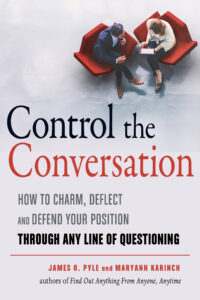How to Charm, Deflect, and Defend
When someone asks a question, you should answer it, right?
Not according to James O. Pyle and Maryann Karinch, authors of Control the Conversation: How to Charm, Deflect, and Defend Your Position Through Any Line of Questioning. They believe you should respond to the question, and they explain more in our discussion below. James O. Pyle is a human intelligence training instructor for the combined services of the Department of Defense. Maryann Karinch is a body language expert and the author or coauthor of 28 books.
After reading their fascinating book, on a topic I love to study, I reached out to them to learn more about their work.
Characteristics of Control
What characteristics do you notice if someone is not good at controlling the conversation?
Here is how this often works in an office environment:
First, the person has a firm agenda that precludes listening. She lays out her points with an intent to control the conversation, but sabotages that desire for control by talking over others. Almost immediately, other people shut her out. They want to reach for the smartphone, grab a cookie—basically do anything that gets them away from her noise. Politicians, CEOs, and even managers sabotage themselves all the time this way. They used their vested power to command attention, but never truly control the conversation.
Contrast that with someone who is spectacular at controlling the conversation.
SpaceX president and COO Gwynne Shotwell comes into interviews with an engaging conversational tone. As she answers questions, she finds ways to work in messages of vision, safety, quality, and so on that inspire a sense of trust in SpaceX technology—it’s easy to find yourself cheering her, and the company, on to greater heights (pun intended). Part of her success in conveying these messages is that she weaves in timelines, expertise of the team, descriptions of specific events, and a sense of location.
Respond, Don’t Answer, a Question
What’s the difference between answering and responding to a question?
Responding to a question is not necessarily answering it. It’s better than that. Just answering a question is providing data, responding is data plus! The response is energized with information, intent, direction, and management. Your response to any and all questions can pack much more power and meaning into it than a mere answer. In the book, we introduce an exercise in the Introduction: answer four questions without knowing the material in the book. We offer the same four questions at the end of the book, and provide responses rather than answers. For example, the first question is, “Where were you on a memorable New Year’s Eve?” Jim’s answer in the Introduction is:
The backyard of my house.
His response at the end of the book is:
New Year’s Eve 1963, my brothers and I took my
mom’s pans and lids into the backyard of our duplex
apartment in Paramount, California, and
beat the thunder out of them at midnight—and
boy, were we in trouble! For the rest of my life in
that home, none of those pan lids fit. Every time
we used them, it reminded me of that night.
Talk about people, places, things, events in time and how these four areas of disclosure can help in answering questions.
Providing multidimensional answers to questions creates opportunities for you – opportunities to reveal talents, tell a memorable story, convey unique knowledge. Most importantly, inclusive responses open the door to dialogue. Whether it’s a job interview, sales meeting, or a first date, instead of the encounter being a bland question-and-answer session, it’s a collaboration. One result: You have at least as much control as the other person does over the conversation.
When you link your responses to the four areas people, places, time, and things you mentally organize information in a way that makes it more complete. Depending on the question, you may naturally focus on one area more than another. The important thing to know is what other types of information you want to make sure the questioner hears.
The four areas also offer you a smoother transition to move away from less productive discussion areas without abrupt and apparent maneuvers as well as steer to the objective area.
How do the best communicators become masters of body language to enhance their message?
They learn to both read and proactively use body language—and the latter is done in a natural way. It is shaped in part by reading the body language of the other person. Body language is part of a conversation, so “pushing” gestures at someone because those gestures are supposed to mean a particular thing is ridiculous and unproductive.
You become a master, if you will, by paying attention to the other person or persons to understand when they trust you, doubt you, are surprised by you, and so on. Your body language is a response to them that is designed to get them into the state of mind you desire.
How to Read Body Language
Reading someone’s body language is fascinating. How do you get really good at it? Would you share a few examples?
The first step to success is putting assumptions aside. Context, culture, body type, gender, and learned behavior are key influences on a person’s body language. For that reason, assuming that someone who is very different from you uses the same movements as you do to convey certain ideas and emotions will derail your ability to read his/her body language.
 Maryann just returned from a business trip to Taiwan. In some ways, notably the younger generations’ skill with English, they are very Western. At the same time, there are distinct cultural differences in the way certain emotions and messages are conveyed. Having been to Taiwan before, Maryann was aware that her ability to be successful in a press conference, at a meeting, or during a banquet partially depended on her ability to read her audience and answer the question: How culturally Eastern or Western are they? In other words, if she were interacting with a very Western-oriented group, she would take that into consideration in determining how she should behave. The point is to read well to use body language that is appropriate for the audience. Having determined that her audience at a meeting was far more Eastern than Western, she extended her arm and hand in a decisive way—not necessarily a gesture she would use with an American audience—in making a key point. It was an aggressive gesture that mirrored the way her Taiwanese host was communicating the same messages.
Maryann just returned from a business trip to Taiwan. In some ways, notably the younger generations’ skill with English, they are very Western. At the same time, there are distinct cultural differences in the way certain emotions and messages are conveyed. Having been to Taiwan before, Maryann was aware that her ability to be successful in a press conference, at a meeting, or during a banquet partially depended on her ability to read her audience and answer the question: How culturally Eastern or Western are they? In other words, if she were interacting with a very Western-oriented group, she would take that into consideration in determining how she should behave. The point is to read well to use body language that is appropriate for the audience. Having determined that her audience at a meeting was far more Eastern than Western, she extended her arm and hand in a decisive way—not necessarily a gesture she would use with an American audience—in making a key point. It was an aggressive gesture that mirrored the way her Taiwanese host was communicating the same messages.
The second step to success is determining whether the other person’s body language is invitational (open), distanced (closed), or neutral.
Jim and Maryann went into a Boston Market together to have lunch. Jim noticed that the people serving had very invitational body language. In short, they were ready to talk and, without a line to deal with, that’s what they did. He asked them questions and found out all kinds of things—from their pre-school kids to their love of mashed potatoes.
The third step is to listen for the tone of voice, pacing, other vocal qualities. They are all part of body language and will clue you in as to whether someone is relaxed, excited, stressed, angry, and so on.
Everyone has experience in reading body language—but not so much the ability to employ it. Think back to your childhood and how you were able to discern, without discussion, family members’ feelings and energies, good and not so good. How often could you decide when was a good time to make a request, or to step back from the family dynamic?
When should you respond with a question?
During a promotional tour for a new movie, actress Keira Knightley was asked how it’s possible to juggle being a married woman and having a career. Without meanness in her voice, Knightley sweetly redirected with: “Are you also asking the men that today?”
Respond to a question with a question when you are:
- Like Knightley, deflecting an offensive question in a courteous way.
- Unsure of the meaning of the question. If someone asks a question in a job interview like, “Are you afraid of snakes?” it’s appropriate to respond with “Do you mean real snakes or human predators?”
- Intent on taking the questioner into different territory. The person asks, “How would you choose between a lucrative contract and less-profitable one that benefits a low-income community?” Your response might be: “Why would you assume that a contract benefitting a low-income community is less profitable?”

